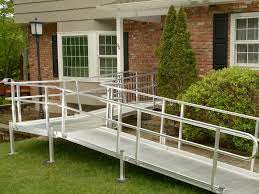
Thinking of Renting a Ramp? 5 Key Factors to Consider Before You Decide
- Joseph Summers
- Health
- 2025-10-10
- 2072K
Ensuring your home or event is accessible is more than just a convenience — it’s about safety, independence, and peace of mind. Temporary mobility challenges, post-surgery recovery, or visiting guests with limited mobility can all create situations where a ramp is essential. While buying a ramp might be an option, renting one is often more practical for short-term needs.
A wheelchair ramp rental can provide the accessibility solution you need without a permanent commitment. However, before you make a decision, there are some key factors to consider to ensure safety, comfort, and convenience. Here’s a breakdown of the five most important things to weigh before renting a ramp.
1. Determine Your Specific Needs
The first step is to clearly define your needs. Ramps come in many styles, sizes, and materials, and choosing the wrong type can create problems. Ask yourself a few questions:
- How long will the ramp be needed?
- Who will use it, and how frequently?
- Will it need to accommodate wheelchairs, walkers, scooters, or all of these?
For temporary or short-term needs, such as recovery after surgery, a wheelchair ramp rental can save money while still providing a safe solution. Long-term use may justify purchasing a ramp instead. Being clear about your requirements helps you choose the right size, weight capacity, and style.
2. Understand Ramp Types and Materials
Ramps aren’t one-size-fits-all. Different types suit different needs, so it’s important to know your options before committing.
Here are the most common types of ramps:
- Threshold Ramps – Small, compact, ideal for minor height differences such as doorways.
- Portable Ramps – Lightweight, easy to move, and perfect for temporary use or travel.
- Modular Ramps – Semi-permanent structures that can be customized and expanded for long-term use.
- Folding Ramps – Designed for mobility and quick setup, often used for on-the-go accessibility.
Portable ramps are particularly useful if you need flexibility or have limited space. Choosing the right material is also important — aluminum ramps are lightweight, durable, and resistant to rust, making them a common choice for rental purposes.
3. Measure Carefully for Safety
Accurate measurements are crucial for both safety and comfort. An improperly sized ramp can be dangerous or difficult to use.
Key measurements include:
- Height of the entry point: Measure from the ground to the top of the step, porch, or doorway.
- Length of available space: Ensure there’s enough room for the recommended slope. The general guideline is a 1:12 slope — for every inch of height, the ramp should be at least 12 inches long.
- Width of the ramp area: Make sure it’s wide enough for wheelchairs or mobility scooters to pass comfortably.
If measuring feels overwhelming, many rental companies offer on-site assessments. Having a professional take precise measurements ensures the ramp fits perfectly and is safe to use.
4. Focus on Safety Features
Even for temporary use, safety is non-negotiable. A high-quality ramp should include features that reduce risk and provide peace of mind.
Important safety elements include:
- Non-slip surfaces for wet or slippery conditions
- Raised edges or rails to prevent wheels from sliding off
- Proper weight ratings to handle the intended user and mobility equipment
- Secure anchoring systems to keep the ramp stable
Portable ramps should be durable and able to handle repeated use without compromising safety. When renting, inspect the ramp carefully before installation to ensure it meets these safety standards.
5. Evaluate Costs, Contracts, and Services
Budget considerations are important, but cost shouldn’t be the only deciding factor. Rental fees vary depending on ramp type, length, and duration.
Here’s what to consider:
- Rental duration: Some companies charge daily, weekly, or monthly rates. Longer rentals may offer discounts.
- Installation and removal fees: Check whether these are included or charged separately.
- Maintenance and support: Ask if assistance is available during the rental period.
- Flexibility: Find out if the rental period can be extended if needed without significant penalties.
Comparing quotes from multiple providers helps you find the best value. Customer reviews and ratings also provide insights into reliability and service quality.
When a Ramp Rental Makes Sense
A wheelchair ramp rental is ideal for situations such as:
- Post-surgery recovery at home
- Temporary accommodations for guests with mobility challenges
- Short-term events like family gatherings or weddings
- Homes with temporary accessibility needs while planning permanent modifications
If you anticipate long-term use, a modular or permanent ramp may be a better investment. Temporary rentals are most beneficial when you only need short-term accessibility without the hassle or expense of a permanent installation.
Tips for a Smooth Rental Experience
To make the process easier, consider the following tips:
- Plan ahead: Don’t wait until the last minute, especially during busy seasons.
- Ask questions: Understand the rental terms, installation process, and support options.
- Check local regulations: Some communities have specific rules regarding ramp placement.
- Test before use: Once installed, walk or roll on the ramp to ensure it feels stable and safe.
These steps can prevent mistakes and ensure a smoother, safer experience.
Quality and Service Matter
Renting a ramp is about more than just equipment — it’s about safety, independence, and peace of mind. Working with providers that specialize in accessibility can make a big difference. They not only provide well-built ramps but also offer guidance on installation, safety, and usage.
Companies that offer a range of mobility solutions, including portable ramps, can provide recommendations tailored to your specific needs. Their experience ensures you get a solution that’s safe, reliable, and practical.
Final Thoughts
Renting a ramp is a convenient, cost-effective way to improve accessibility for temporary situations. By understanding your needs, choosing the right ramp type, taking accurate measurements, and prioritizing safety, you can make the rental process smooth and worry-free.
Whether it’s for short-term recovery, visiting guests, or temporary events, carefully considering these factors ensures that your rental ramps provide comfort, safety, and independence. Taking the time to plan and choose wisely will make a big difference for both users and caregivers, giving everyone peace of mind and mobility freedom.
Leave a Reply
Please login to post a comment.












0 Comments